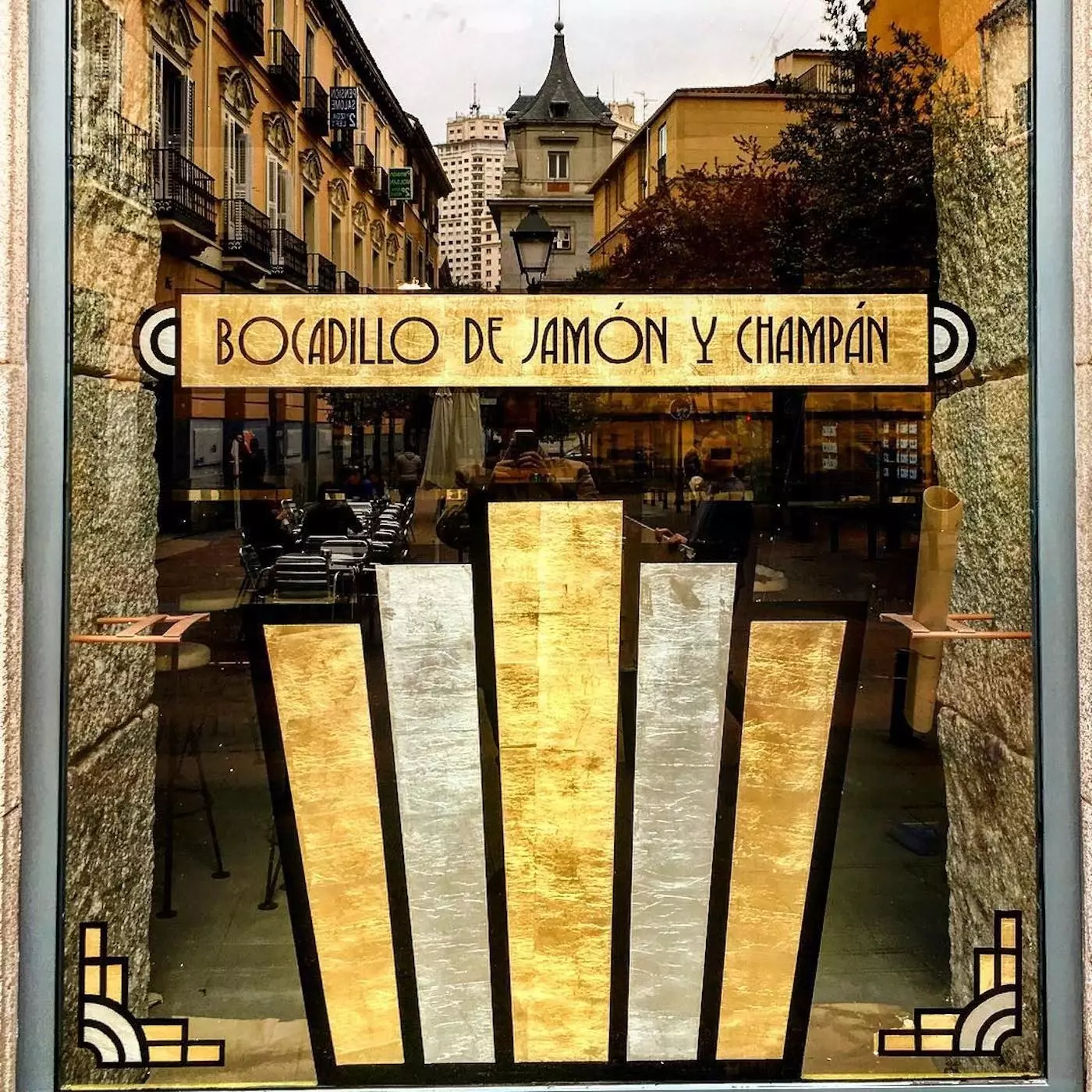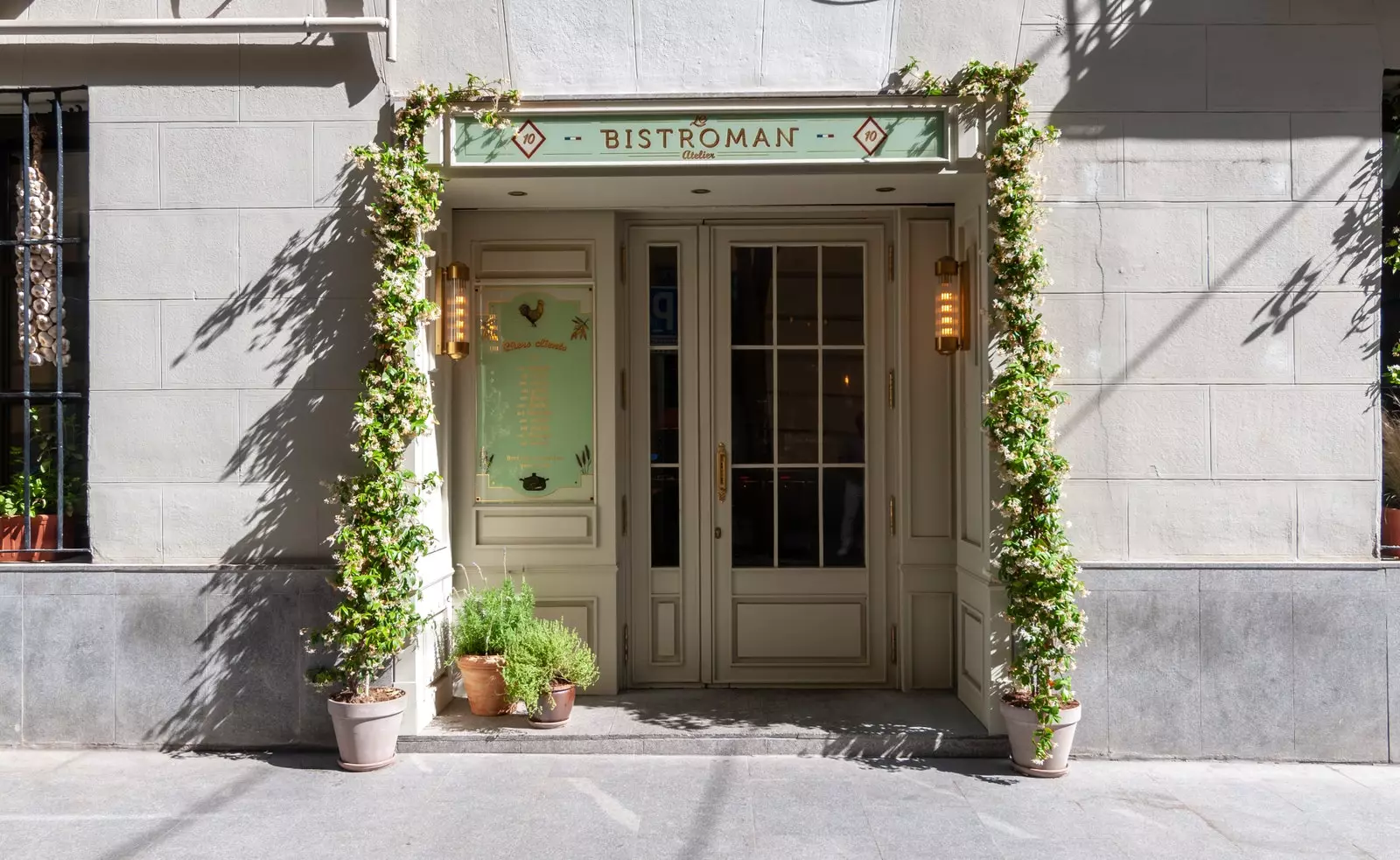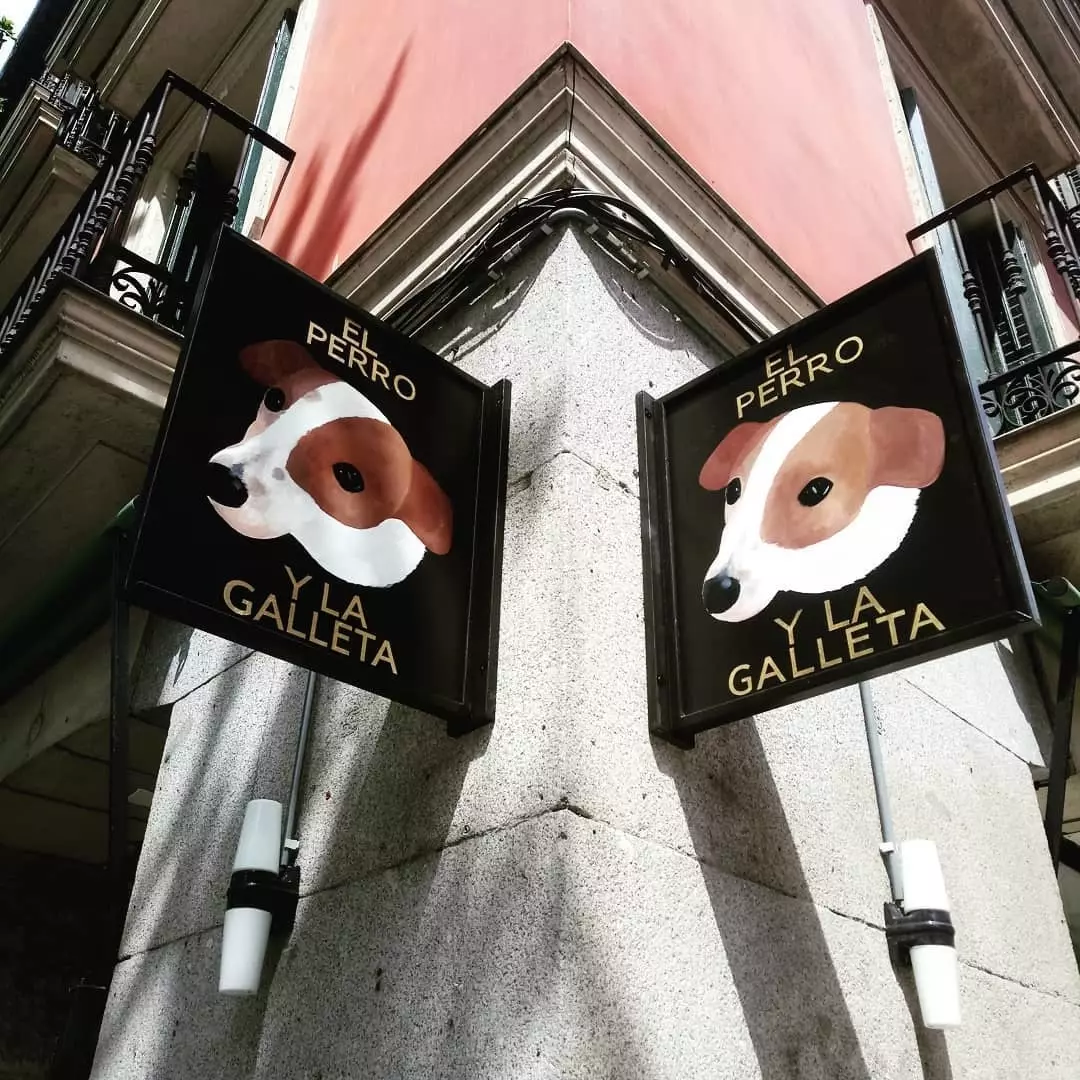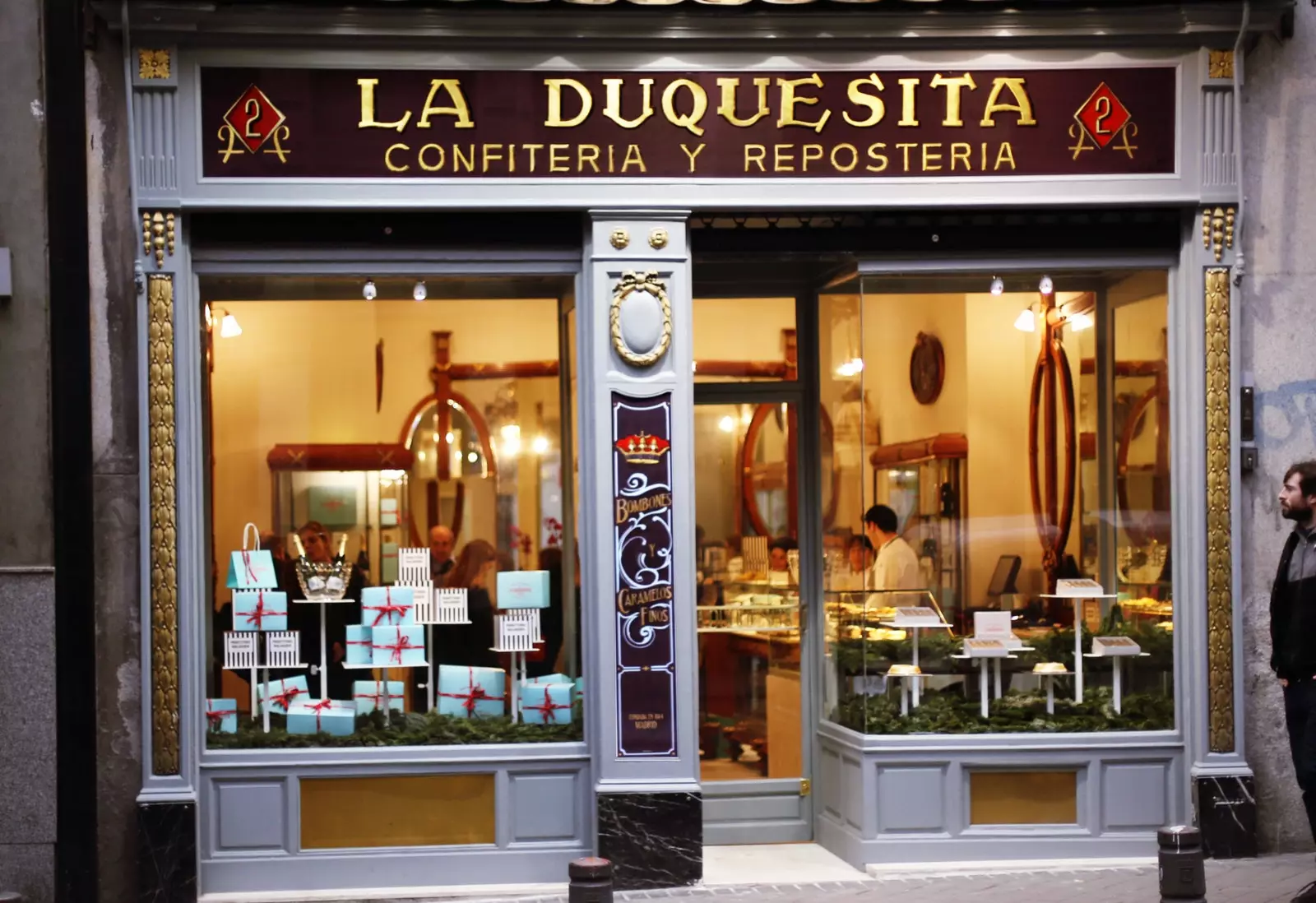
One of the showcases of Bocata de Jamón y Champagne converted into an art deco façade by Freehand Lettering and Art.
Walk down the street in a hurry. Or pause but not pay attention. Staring at the sidewalk or, what is worse, at the mobile. So many things escape us . Formerly when the rush was not so much and the mobile phone was not even imagined, the people of Madrid admired each of the facades of the premises of their city . The signs of plumbing, bars, bookstores or haberdashery presented themselves to passers-by almost as works of art and claim for the entrance of curious. So, to each sign craftsman a neighborhood belonged to him. So it was established.
Malasana , for example, was the fief of Angel Gimenez Ochoa , which meant that no other person should operate in that area, nor could Ochoa sign in a place, for example, on Goya Street. From his workshop came works that are still preserved today in the streets of the center, such as the mythical Casa Fidel or Casa Quiroga . Vestiges of what was the golden age of lettering in Madrid, between the end of the 19th century and the beginning of the Civil War, and that now he is living a deserved and necessary resurgence.

Labeling by Hand was in charge of giving Le Bistroman a French touch with this glass and 22-carat gold sign.
“Today I think there is a lot of interest in lettering thanks to the documentary Sign Painters which premiered about six years ago and was a hit. Now many want to learn to paint and people appreciate things made by hand because they have something, they have soul, personality and individuality ”, he explains to Traveler.es Thomas Graham, letterer behind the studio Freehand Lettering and Art and a lifelong craftsman who barely understands technology: “My only computer is the mobile calculator. I use it to calculate VAT and nothing else. I do everything with brushes, gold leaf, enamels, wood, glass... I do not use methacrylate or vinyl”.
His are the signs that welcome trendy restaurants like Ham and Champagne Sandwich, Orchard of Carabana , El Perro y la Galleta, Santa Canela, Casa Baranda, or the already mythical bar Corazón de la calle Valverde. “I have painted so many that I have forgotten. Sometimes I go to a part of the city and I see one and I think: I painted this one 15 years ago. For example, in Malasaña, in San Vicente Ferrer with Corredera Alta de San Pablo , there is a pub called Triskele . I painted those signs in the kitchen of my old apartment in 2000, and they are still there... in perfect condition!” Thomas, like Ochoa, is becoming an essential part of Malasaña.

Thomas was in charge of creating the dogs that welcome us to the Dog and the Cookie from Carranza Street.
The career of this Englishman does not understand fashions for lettering or hipster documentaries. his thing is pure and hard vocation , and his training began like that of traditional artisans, with a teacher: “I learned in my town, in Bournemouth, on the south coast, between 94 and 98. My father was a graphic designer, obviously in the old style of the 70s, without computers and** everything by hand, and my maternal grandfather was a sign maker**. We lived with him and, in the house, there were always letters. I started painting airplanes with his lettering brushes. Then I worked in a sign company. There I had a teacher who taught me. It was a real apprenticeship."
And as in the best television stories of Spanish expatriates around the world, Thomas came to Madrid for love : “My wife is Spanish, I met her in 1997, she was studying English in my town and here we are, 23 years later with two children and a mortgage”. Since then he lives from his other love of his, the labels, and distributes his art throughout Madrid . “I don't think I'm an artist, I'm a craftsman, and I'd rather be a good craftsman than a bad artist. My father is a true artist and I see the difference between his passion, on a personal level, and my passion, on a professional level”.
Although each craftsman has his own techniques, the ones Thomas employs are practically the same as he was a century ago: “I propose the design to the client and then I make a template on paper, with a pencil . Then I go over it with permanent marker, stick it to a glass and paint with brushes on the other side, upside down. I apply the gold leaf that then stays on the glass, and mount it in a wooden box for exteriors”. This does not mean that their methods of the last century are not adapted to the new times.
In his workshop, in addition to glass signs, blackboards and shop windows , now, also, they are painted partitions as protection against coronavirus : “A partition does not have to look like a hospital. It doesn't have to be a perspex piece between tables in a restaurant where the owner or owner understands the value of aesthetics. It is more about creating a private space, something more exclusive. It is one more piece of decoration, and it can be well built and personalized with a logo”.
Like Thomas, Diego Apesteguia , the craftsman behind the workshop Hand Lettering , he feels very lucky to work in this business. And we hope that he contributes to making our streets much more beautiful: “Beyond the fact that I like the profession, I have the feeling that I am contributing a little to creating a more pleasant city which I associate with a classical Europe and a artistic environment and care , and that goes against that whole modern world in which everything is standardized and is throwaway. But the ultimate value is behind our clients, that there is someone who between making a crappy 300-euro sign or one for a thousand currado, decides the latter, not only for the love of his business, also because it is contributing to the city ”, He elucidates from the workshop that he opened in 2010 in Puerta del Ángel.
It's hard to talk to Diego. He finds a hole where he can to serve us because there is not a minute of calm in this study in which, after the good custom of labeling was lost in the cities, a new resurgence is being experienced. “ In Madrid and Barcelona , the last remaining teachers of the traditional school I think they stopped working in the 70s and 80s . At that time they took more modern signs and above all it disappeared due to the lack of demand. Suddenly people liked it neon, plastic, vinyl… and new cheaper techniques”.
Impossible to understand what we saw attractive in that aesthetic of four decades ago, especially if we take a look at some of the works of Rotulaciones a Mano throughout the country -the Vermouth San Jaime , from Palma de Majorca; Cadaqués, in Barcelona; Le Bistroman, in Madrid; or Orio in Seville - to realize that going back to the style of the early 20th century was not an option.
Who could resist not entering La Duquesita when the glitter of the gold leaf of its letters screams at us (we recommend you see the making of of the elaboration of its sign, it is addictive). “ If you want to transmit elegance, a classic vibe and all that cultural value that a European city is supposed to have, all of that is conveyed by these labels. As McLuhan said, the medium is the message. You are sending a message, you are saying that this is not a business like any other, that all the details are taken care of here”.

the little duchess
Diego studied Psychology and Fine Arts , two disciplines apparently so disparate that he instead planned to unite by devoting himself to advertising. His career and his interest in art led him to make murals and graffiti . “ One day I made a click and said: but the labels are really cool and no one is making them. Little by little I learned to do the gold and glass thing while I was doing murals, and jobs began to come out. It's a whole step-by-step process." Many steps he had to take until he learned the trade. “What I have learned has been a mix of modern things with tradition , just like we do. There is a very important component of self-taught, based on YouTube and digging in old bookstores , especially in the United States, which has a lot of scanned books. He was looking for old manuals from the West or from the turn of the century to see the techniques and how things were done. And the traditional part is to do workshops and visit teachers, in this case abroad”.
Something innate must also have . Seeing the processes of making his labels and, of course, the final result, we are convinced that the hands of Thomas and Diego have some gift hidden from the rest of mortals, although both insist on downplaying it. “The most difficult part is the management part. Any craftsman will tell you the same. Every time we start painting everything is easy . I don't care if I have to repeat a piece three times, that's the part I enjoy the most”, Diego clarifies that when we ask him why he doesn't dare to give courses in his workshop, he answers, surprisingly, that he is not ready yet: “ Maybe when I'm 50”.
